- Quick Read
- Deep Read ( 4 Min. )

Why is Christian Science in our name?
Our name is about honesty. The Monitor is owned by The Christian Science Church, and we’ve always been transparent about that.
The Church publishes the Monitor because it sees good journalism as vital to progress in the world. Since 1908, we’ve aimed “to injure no man, but to bless all mankind,” as our founder, Mary Baker Eddy, put it.
Here, you’ll find award-winning journalism not driven by commercial influences – a news organization that takes seriously its mission to uplift the world by seeking solutions and finding reasons for credible hope.
Explore values journalism About usIn Today’s Issue
- Giant California fire fits a pattern: Rising risks, human causes
- Today’s news briefs
- What to know about Kamala Harris’ border security record
- They stepped away for mental health. Their comebacks are powering the Olympics.
- Can that gas be remoooved? The quest for climate-friendly cows.
- Poland has united to cut back on coal. This activist led the way.
Monitor Daily Podcast
- Follow us:
- Apple Podcasts
- Spotify
- RSS Feed
- Download
TODAY’S INTRO
Cows and climate
 Mark Sappenfield
Mark Sappenfield
Today, we offer you a cow in a box. Not as a Christmas present. But in Stephanie Hanes’ story about how scientists are trying new things to understand the potent greenhouse gas produced by cows.
The study is more than just a curiosity. Yes, the photo does look like some sort of deepfake bovine Marvel film. But the story behind it speaks to a crucial ingredient in any attempt to conquer climate change: innovation. And sometimes, it seems, that means thinking inside the box. With a cow.
Share this article
Link copied.

Help fund Monitor journalism for $11/ month
Already a subscriber? Login

Monitor journalism changes lives because we open that too-small box that most people think they live in. We believe news can and should expand a sense of identity and possibility beyond narrow conventional expectations.
Our work isn't possible without your support.
Giant California fire fits a pattern: Rising risks, human causes
California is wrestling with a giant wildfire in a year that’s already seen five times the annual average of acres burned in the state. Solutions may require changes in strategy and expectations.

Northern California’s Park Fire, now the largest active fire in the United States, has scorched nearly 370,000 acres since it began on July 24 – signaling hard lessons facing vulnerable regions of the American West.
Thousands of residents have been ordered to evacuate in four counties – including Butte County, where the 2018 Camp Fire killed 85 people and destroyed more than 18,000 homes and other structures.
The Park Fire has moved swiftly, with high winds funneling flames through steep mountain terrain, and triple-digit temperatures exacerbating intense heat. Already it’s among the largest wildfires in California history.
The state is wrestling to control the situation, but with rising costs and growing humility.
“It’s a big fire. We don’t typically get them this early in the fire season,” notes Capt. Dan Collins with Cal Fire, as California’s Department of Forestry and Fire Protection is called. “We’ve already had 10 to 11 incident management team deployments in Cal Fire so far this year. We’re not even in August yet.”
Giant California fire fits a pattern: Rising risks, human causes
Northern California’s Park Fire, now the largest active fire in the United States, has scorched nearly 370,000 acres, or 580 square miles, since it began July 24 – signaling hard lessons facing vulnerable regions of the American West.
Thousands of residents have been ordered to evacuate in four counties – including Butte County, where the 2018 Camp Fire killed 85 people and destroyed more than 18,000 homes and other structures. Officials lifted some of those evacuation orders Monday morning.
As the wildfire presses north and the state wrestles to control the outbreak, the fire’s magnitude – and the resources needed to bring it under control – reinforce a growing humility and respect for nature’s force.
“It’s a big fire. We don’t typically get them this early in the fire season,” notes Capt. Dan Collins with Cal Fire, as California’s Department of Forestry and Fire Protection is called. “We’ve already had 10 to 11 incident management team deployments in Cal Fire so far this year. We’re not even in August yet.”
The Park Fire moved swiftly in its first few days last week, with high winds funneling flames through steep mountain terrain, and triple-digit temperatures exacerbating already intense heat. As of Monday morning, the fire was 12% contained, with nearly 5,000 emergency personnel working to suppress it, helped by the weekend’s cooler weather and increased humidity.
Human causes and consequences
Officials have arrested and charged a man with starting the fire – now the sixth-largest wildfire in California’s history – in a year that’s seen five times the five-year average of acres burned in this state so far.
The Park Fire, which has also burned scores of homes and buildings, was one of more than 100 wildfires burning in the U.S. this past weekend. Nationwide, as of late July, wildfires have burned more than 4 million acres across the U.S. – well above the 10-year average.
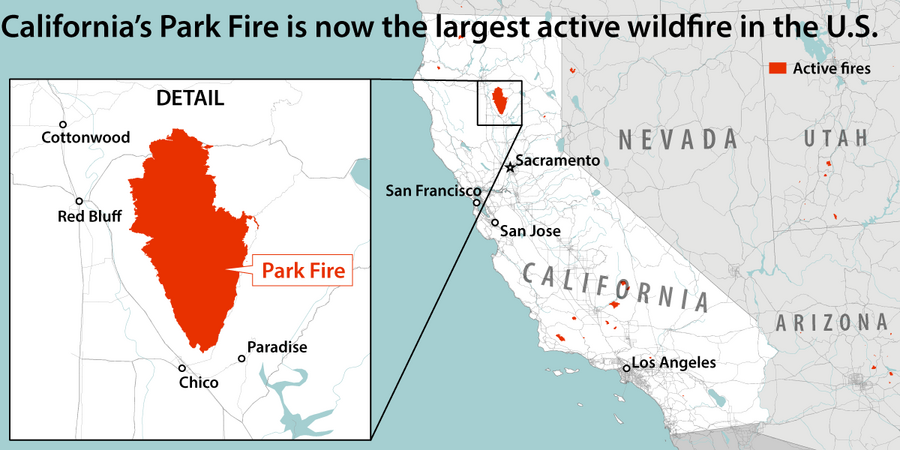
Canada, too, is wrestling with the challenge this summer. The Jasper Wildfire Complex, in Alberta, has already burned nearly 80,000 acres and destroyed half of Jasper, a historic town bordering Jasper National Park. The fire, which also started last week and forced more than 25,000 people to evacuate, was so intense it created its own weather event, fire-fueled thunderstorms involving what are called pyrocumulonimbus clouds.
A record number of wildfires in Canada last year forced more than 235,000 Canadians to evacuate and sent thick smoke into the U.S.
Increasingly, efforts at wildfire prevention and mitigation are coming alongside a rising “live with fire” ethos.
“We’re going to have to learn to live with it,” says Sean Triplett, head of tools and technology for the National Interagency Fire Center. “That’s going to require different evolving strategies as the landscape changes. We have to be adaptable and change with it.”
Wildfire risks rise with temperatures, fuel – and arson
The Park Fire underscores some challenges in that kind of adaptation.
- High temperatures and high winds: These conditions are propelling the fire’s fast spread – and create ongoing wildfire risks as 2024 breaks global heat records. Experts say climate change has also increased the frequency of lightning strikes, which can spark fires in hot, dry conditions.
- Fuel: California recently had two years of heavy rains and fewer-than-usual acres burned, creating vegetation-heavy forest floors. The state historically favored fire suppression – avoiding fires or extinguishing them as soon as they start. But in recent years, forest and fire experts have called for controlled burning to reduce fire “fuels” and allow forests to naturally regenerate.
- Arson: Cal Fire arrested a Chico man within days of the fire’s ignition, saying he was seen pushing a burning car into a gulley. Most wildfires – 88% on average – are sparked by humans.
At the same time, wildfire management experts describe momentum around new solutions. A sharp increase in wildfire destruction over the past decade brought a surge of interest from government agencies tasked with managing fires, as well as from private enterprise.
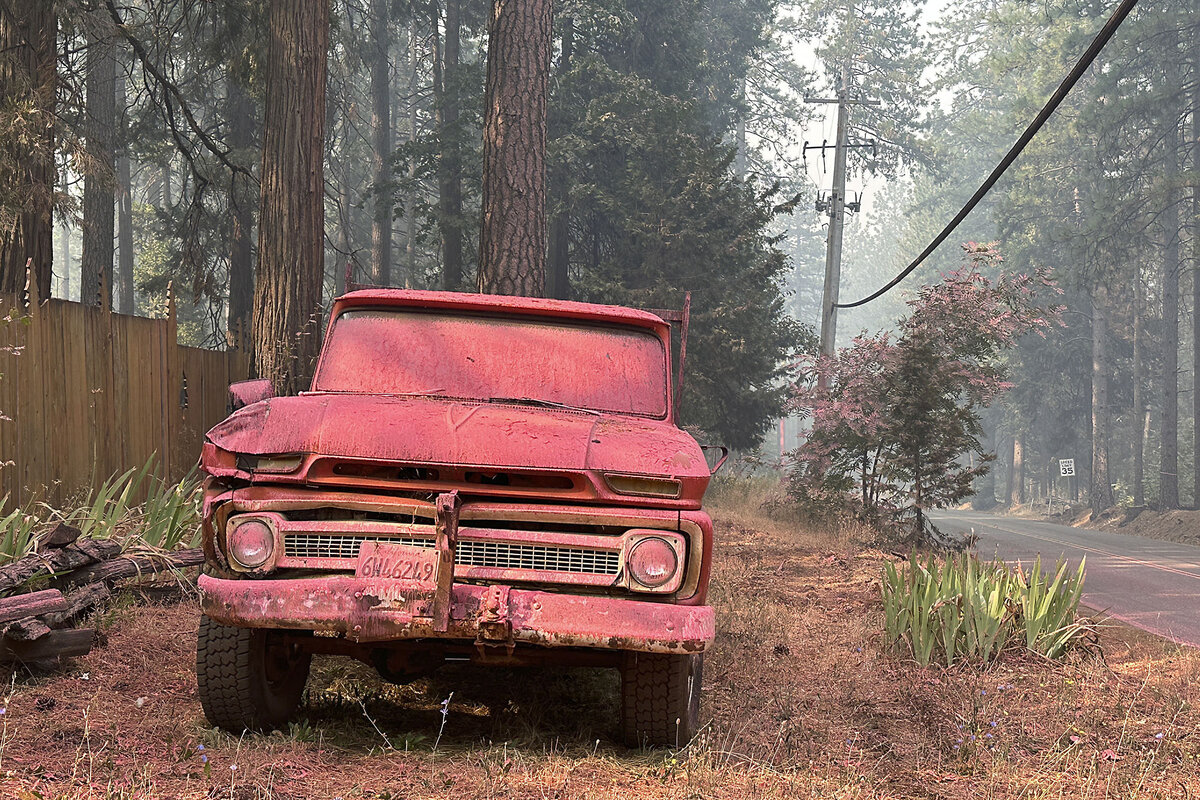
Fast-evolving technologies – especially those using artificial intelligence and satellites – are enabling early detection and helping emergency responders predict and plan for risks. Communications systems are advancing. And public-private partnerships are driving innovations.
“That’s the exciting part,” says Bob Roper, policy adviser for the Western Fire Chiefs Association. “We don’t really have much control [of wildfires]. But we’re getting a better understanding of how to address it through the use of AI and early detection.”
But the Park Fire shows how tough it is to rein in flames once they take off. Especially when the weather is hot and dry and there’s lots to burn, nature has the advantage.
Living with fire
A 2023 federal report calls wildfire across the U.S. a crisis that is “urgent, severe, and far reaching.” And a 2022 study by First Street Technology, which researches climate risks, finds that more than 70 million homes have some degree of risk from wildfire. The group projects 80 million homes will be at risk by 2050.
Preventing wildfire before it starts is key to reducing fire-related devastation.
Intentionally set, or prescribed fires, and fuel management – clearing away grass, twigs, and other easy-to-ignite vegetation – already happen year-round in high-risk areas. Residents are also encouraged to use fire-resistant building materials and clear any flammable plants or items from around their homes for at least a 5-foot buffer to slow down flames.
“Everybody thinks that we’re just going to put out every fire. And the true issue is we’re not going to suppress our way out of this,” says Mr. Roper, speaking to the Monitor from the site of 2021’s Dixie Fire in Northern California. He adds, “This isn’t going anywhere soon.”


Today’s news briefs
• Supreme Court proposal: President Joe Biden unveils a long-awaited proposal for changes at the U.S. Supreme Court, calling on Congress to establish term limits and an enforceable ethics code for the court’s nine justices.
• Venezuela election: Venezuelan President Nicolás Maduro is formally declared the winner of his country’s disputed presidential election, handing him a third six-year term.
• U.S. interest rates: One year after leaving its benchmark interest rate at a near-quarter-century high, the Federal Reserve is expected to signal this week that it will likely reduce borrowing costs as soon as September.
• France vandalism: The French government says multiple telecommunications lines have been hit by acts of vandalism, affecting fiber lines and fixed and mobile phone lines as cities across France are hosting events for the 2024 Paris Olympics.

The Explainer
What to know about Kamala Harris’ border security record
As Vice President Kamala Harris launches her presidential bid, opponents link her to unpopular Biden administration border policies. We untangle the debate over her immigration tasks.

- Quick Read
- Deep Read ( 6 Min. )
U.S. Vice President Kamala Harris has unified her party behind her presidential candidacy. Yet she’s also inheriting major political problems – record levels of illegal border crossings in recent years and a broken immigration system. The Republican Party paints those as largely the failure of the current White House.
That includes claims that Ms. Harris served as President Joe Biden’s “border czar.” House Republicans and six Democrats approved a symbolic resolution on Thursday that reiterates the controversial title and condemns Ms. Harris for failing to secure the border.
Mr. Biden tasked the vice president, in 2021, with a diplomatic role to address the causes of migration from Mexico and Central America and to work with those countries to strengthen migration enforcement at their own borders.
Following that announcement, some Republicans began to dub Ms. Harris the “border czar.” Several media outlets also began to apply the moniker to the vice president. On Wednesday, Axios posted an editor’s note saying it had “incorrectly” used the term previously.
Remedying a long-failed immigration system, amid historically high migration globally, “takes an all-of-government, multiadministration commitment,” says Angela Kelley, former senior counselor for immigration and the border at the Department of Homeland Security.
What to know about Kamala Harris’ border security record

Not even a week into her sudden candidacy for the White House, Vice President Kamala Harris appears to be facing more attacks on one issue than on any other: the southern border crisis during the Biden presidency.
Since President Joe Biden on Sunday stepped out of the presidential race, Ms. Harris has unified her party behind her candidacy. Yet Republicans have immediately pounced on immigration as a vulnerability for her. They cite record levels of illegal border crossings in recent years and a broken immigration system. The GOP paints those as largely the failure of the current White House.
Critics point to the claim that Ms. Harris served as the president’s “border czar” and failed. House Republicans and six Democrats approved a symbolic resolution Thursday that reiterates the controversial title and condemns the administration, and Ms. Harris in particular, for failing to safeguard the border against unauthorized immigrants and national security threats. But the meaning of her role on the issue is more nuanced.
Was Kamala Harris the “border czar”?
In 2021, President Biden did task the vice president with a diplomatic role to address the causes of migration from Mexico and Central America – such as violence and political instability – and to work with those countries to strengthen migration enforcement at their own borders. The assignment was similar to one Mr. Biden received as vice president in the Obama White House.
At the time, President Biden said he asked the vice president “to lead our efforts with Mexico and the Northern Triangle and the countries that help – are going to need help in stemming the movement of so many folks, stemming the migration to our southern border.”
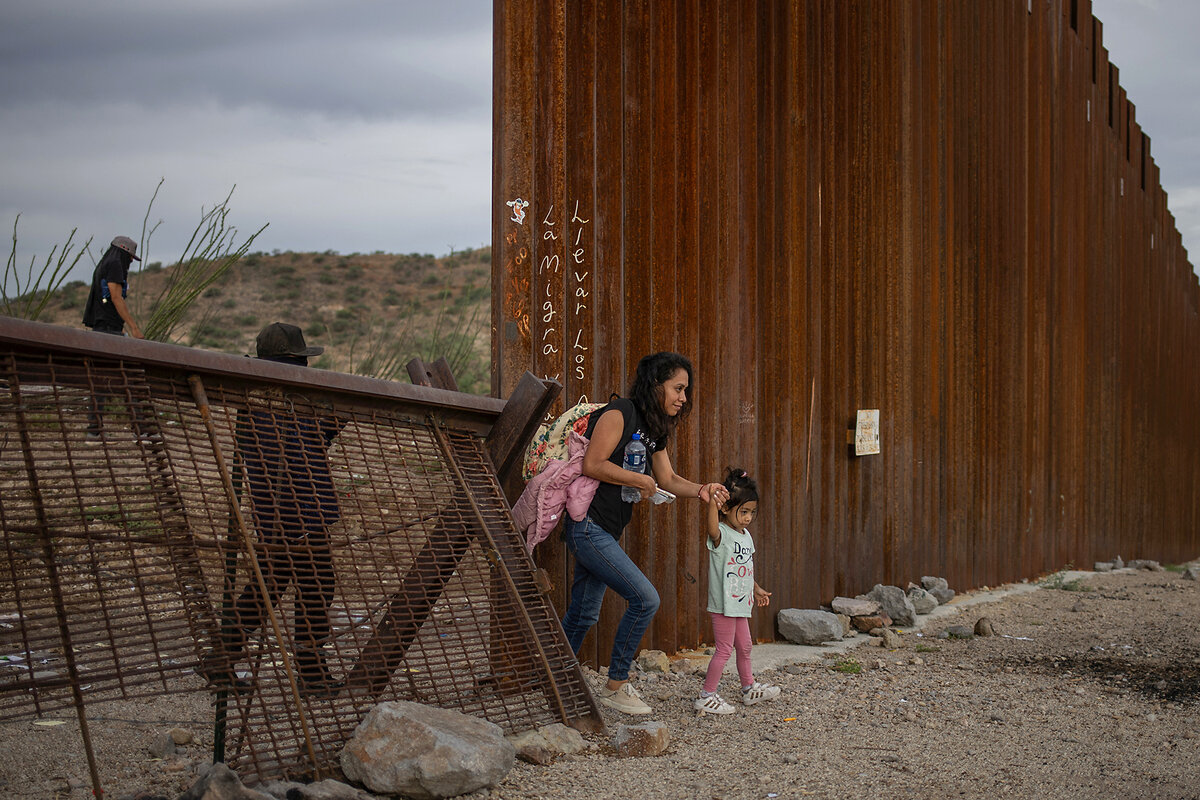
Following Mr. Biden’s announcement, Texas Republicans began to dub Ms. Harris the “border czar.” Several media outlets also began to apply the moniker. On Wednesday, Axios posted an editor’s note saying it had “incorrectly” used the term previously. Neither the Department of Homeland Security nor a White House spokesperson responded to Monitor requests seeking to clarify Ms. Harris’ role.
The term “czar” has been used by the media and policymakers for decades to describe certain government officials, especially as a quick substitute for complicated official titles. Franklin D. Roosevelt had a czar for shipping during World War II, Richard Nixon had an “energy czar” in the 1970s, and George W. Bush and Barack Obama both had over 30 officials in their administrations dubbed with that term, writes Tom Shoop, former editor-in-chief of Government Executive Media Group.
“The use of the term is somewhat squishy, because it’s never been an official designation,” Mr. Shoop says in an article last year about how the Russian word became applied to U.S. officials.
Nonetheless, the Republican line of attack is clear.
“If she becomes president, Kamala Harris will make the invasion exponentially worse,” former President Donald Trump said Tuesday on a call with reporters. “I will terminate every open-borders policy of the Biden-Harris administration.”
Mr. Biden departs the race just as monthly Border Patrol encounters with migrants along the southern border dropped in June to their lowest level since his first month in office. The White House credits new restrictions around entry and asylum access enacted last month, along with more enforcement in Mexico.
Angela Kelley, former senior counselor for immigration and the border at the Department of Homeland Security during the first two years of the Biden administration, says remedying a long-failed immigration system isn’t just the job of one person. Amid historically high migration globally, she says it “takes an all-of-government, multiadministration commitment.”
What was her role on the U.S. southern border?
The level of Ms. Harris’ involvement with immigration policy at the southern border is under debate. Though influenced by executive action, immigration enforcement is largely carried out by the Department of Homeland Security, whose secretary, Alejandro Mayorkas, House Republicans impeached this year.
In April 2021, shortly after Mr. Biden’s announcement of her immigration role, Ms. Harris drew a line between her task and that of Secretary Mayorkas.
“The President has asked Secretary Mayorkas to address what is going on at the border, and he has been working very hard and is showing some progress because of his hard work. I have been asked to lead the issue of addressing the root causes,” she said in response to a reporter’s question. She added that those causes “are not issues that are going to be addressed overnight.”
In June 2021, Ms. Harris visited Mexico and Guatemala. Her message to migrants? “Do not come,” she said in Guatemala City. “Do not come.”
Migrants would, however, continue to come. That messaging had “very minimal effect,” says Theresa Cardinal Brown, senior adviser for immigration and border policy at the Bipartisan Policy Center. Similar statements have had “minimal effect from government officials for a long time,” she adds.
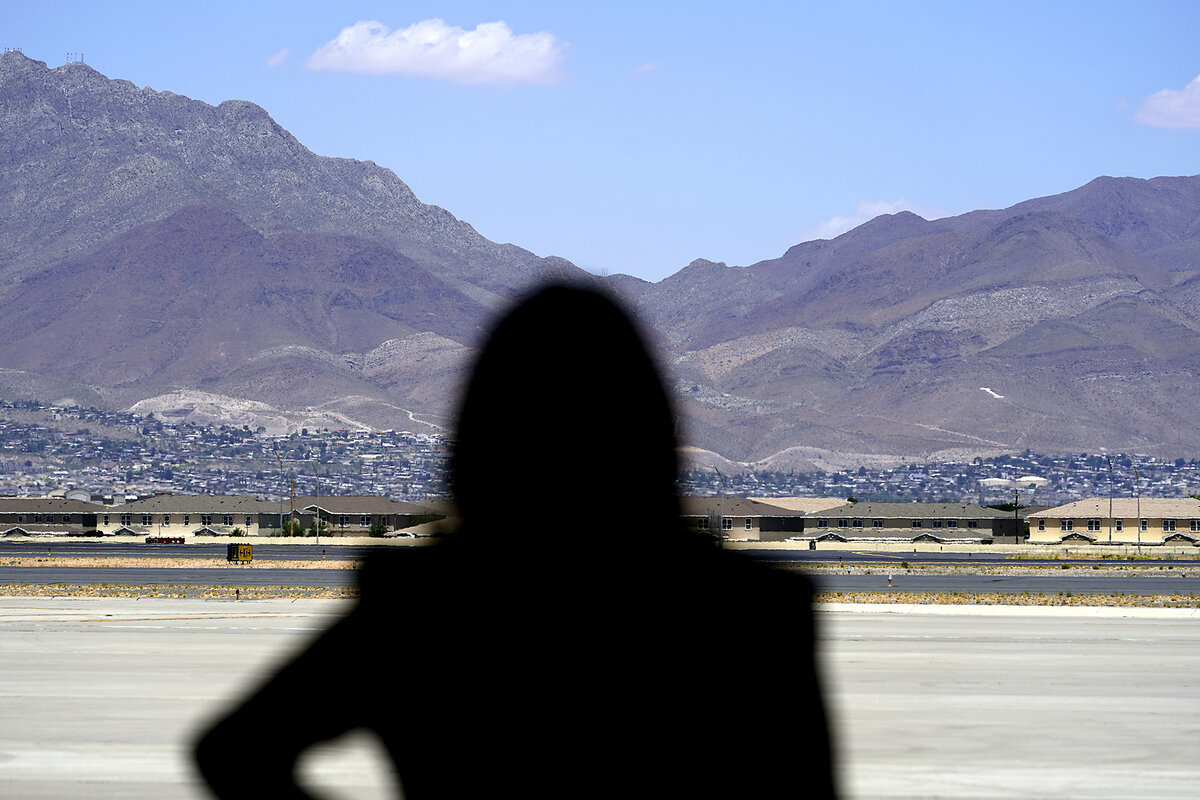
Immigrant advocates, meanwhile, were disappointed by Ms. Harris’ words. Under U.S. law, immigrants who enter illegally (between ports of entry) may still apply for asylum. Mr. Biden’s recent actions limiting asylum claims face lawsuits from immigrant rights groups.
How has Ms. Harris talked about the border?
A defensive interview with NBC News during her 2021 Guatemala trip brought Ms. Harris further criticism by Republicans and border Democrats for having not yet visited the U.S. southern border.
Within the month, the vice president went to the border at El Paso, Texas. As she visited immigration facilities and met young migrant girls, she framed the crisis in humanitarian terms.
The children reminded her, said Ms. Harris, “of the fact that this issue cannot be reduced to a political issue. We’re talking about children, we’re talking about families, we are talking about suffering.”
While migration from the Northern Triangle has declined, that hasn’t been enough to curb record-high illegal border crossings during the Biden administration overall, representing dozens of countries. No single factor can explain these dynamics, experts say. And while Ms. Harris announced more than $5.2 billion in private-sector commitments to Northern Triangle countries (Guatemala, Honduras, and El Salvador) as of this year, in part to create jobs, the status of those funds is unclear.
On Tuesday’s call with Mr. Trump, the former head of the Border Patrol union expressed frustration with the White House.
“Instead of addressing cartels and the human devastation they cause to migrants and U.S. citizens alike, she tried to explain away the crisis as a climate and political instability issue,” said Brandon Judd, former president of the National Border Patrol Council.
While conservative critics say the loosening of Trump-era border restrictions attracted more migrants, the White House lays blame on gridlocked Congress.
“We are very clear, and I think most Americans are clear, that we have a broken immigration system and we need to fix it,” Ms. Harris told ABC News in March. She blamed Senate Republicans for rejecting a bipartisan border security deal after Mr. Trump disparaged it.
“The former president would prefer to run on a problem than fix a problem,” she said.
How have her immigration views evolved?
Her public service began in California, a border state with the nation’s largest foreign-born population. After serving as district attorney of San Francisco beginning in 2004, Ms. Harris was elected state attorney general in 2010.
Ms. Harris advocated for immigrant victims of crimes, and held mixed positions on what are often called “sanctuary policies.” While district attorney, she approved of local law enforcement working with federal authorities on arrests of juvenile unauthorized immigrants. Later, as attorney general, she advised that complying with requests by Immigration and Customs Enforcement (ICE) regarding unauthorized immigrants was voluntary for local officials.
The Californian went on to serve in the U.S. Senate from 2017 to January 2021. There she advocated for “Dreamers,” unauthorized immigrants who were brought to the United States as children. She challenged the Trump administration’s family separation policies, made a call to “critically reexamine ICE,” and disapproved of Mr. Trump’s attempts to build more border wall.
“I am a strong believer in border security,” she wrote in her memoir, “but experts agree that a wall will not secure our border.” She also argued that funding could be better spent on the opioid crisis, rural broadband, and critical infrastructure.

They stepped away for mental health. Their comebacks are powering the Olympics.
Previous generations of Olympic athletes were expected to perform with smiles on their faces, even when dealing with physical pain, mental trauma, or outright abuse. Today’s athletes are more open about their battles, and say that honesty about mental health has led to a better balance in their lives.

- Quick Read
- Deep Read ( 5 Min. )
Surfer Carissa Moore, a five-time world champion and Tokyo Olympic gold medal winner, is open about having dealt with challenges on her ladder to the top.
“I actually hit a mental slump post-winning my third world title,” she explained at a spring media event in New York. She added that she felt like she was competing for everyone else at one point.
“I hit rock bottom and was a bit depressed, had feelings of anxiety, and that’s when I decided that, ‘OK, things have got to change. Surfing has always been joyful,’” she said.
Mental health is no longer a taboo topic at the Olympics. Crowd-wowing performances from gymnast Simone Biles and swimmer Caeleb Dressel demonstrate their resilience and determination. But their comebacks have also broadened the discussion around support for mental health among Olympians. They offer examples of how athletes have sought their own approaches to navigating balanced lives, despite the intense spotlight of the Games.
“Some athletes have been courageous enough to talk about the challenges that it takes to develop those coping skills,” says Joel Fish, who runs the Center for Sport Psychology in Philadelphia and has worked with Team USA’s women’s field hockey and soccer teams.
They stepped away for mental health. Their comebacks are powering the Olympics.
Gymnast Simone Biles is not only smiling at the Olympics again. She is also competing. So is swimmer Caeleb Dressel. Both highly decorated athletes left their sports after the last Olympics in Tokyo to take a mental health break. Both weren’t sure they would be back.
Over the weekend, Ms. Biles pushed through a calf injury and led the U.S. women’s gymnastics team to a first-place finish in the team qualifying round, expertly performing a vault, for example, that is considered the most difficult in the world. Mr. Dressel anchored the last leg of an explosive men’s 4x100 freestyle relay – helping to deliver the country’s first gold medal of the Paris games.
Their crowd-wowing performances demonstrate their resilience and determination. But their comebacks have also broadened the discussion around support for mental health among Olympians – and offer examples of how athletes have sought their own approaches to navigating balanced lives.
“Some athletes have been courageous enough to talk about the challenges that it takes to develop those coping skills,” says Joel Fish, who runs the Center for Sport Psychology in Philadelphia and has worked with Team USA’s women’s field hockey and soccer teams.
The pressure to win at the Olympic and pro level “has become so intense,” he adds. Dr. Fish cited the immediacy of intense feedback from social media as a game changer for added pressure on athletes. Being placed under a microscope enhances the pressure to win, he says. Athletes need to develop a sense of themselves that is independent of their sport.
“They stand a better chance when they’re under the major spotlight like the Olympics,” Dr. Fish says, “because their identity isn’t wrapped up in how they perform.”
Ahead of the women’s gymnastics debut on Sunday, former Olympian and gymnastics coach Chellsie Memmel spoke about Ms. Biles’ mindset.
“Seeing her now, I think she’s in a really good place,” Ms. Memmel says. “She’s excited about gymnastics, she’s enjoying it, and I think this is a redemption for her.”
Why Simone Biles stepped away
Although athletes’ mental health has always been a concern at the Olympics, Ms. Biles surprised the world in Tokyo in 2021 when she resigned from most of the competition due to a case of the twisties – a dangerous disconnect between her mind and body while in the air. That year, she was part of the silver-medal winning women’s team and earned a bronze medal in the individual balance beam event.

In 2022, Mr. Dressel – fresh off winning five gold medals the previous year in Tokyo – took an eight-month break from swimming after withdrawing from the world swimming championships. Like Ms. Biles, he turned to therapy for help.
How are U.S. Olympians being cared for?
Other Olympians have also struggled – with anxiety, eating disorders, and emotional breakdowns. The United States Olympic and Paralympic Committee (USOPC) has responded in recent years by hiring new mental health staff.
“I do think that athletes speaking up more has helped us drive the conversation around mental health and well being – and being able to take a break and be able to take care of your mental health,” Jess Bartley, USOPC senior director of psychological services, said at an Olympic media event in New York in the spring.
She credits athletes advocating for themselves, and adds that overall there has been a move toward destigmatizing mental health awareness.
Dr. Bartley was hired in December 2020 after the Tokyo Games were postponed due to COVID-19. She and her then-six-member staff of mental health specialists saw some of the first instances of athletes who had trained for four years feeling deflated because they couldn’t compete.
She now has a staff of 15 people, all of whom are on the ground in Paris. Before they arrived, her team took steps such as making sure every competing athlete went through at least one mental health screening annually.
“I think there’s a lot of gratitude for the resources,” said Dr. Bartley, who added that her office is integrated into the national governing bodies of Olympic sports.
Surfer Carissa Moore, a five-time world champion and Tokyo Olympic gold medal winner, says she’s dealt with challenges on her ladder to the top.

“I actually hit a mental slump post-winning my third world title,” she explained at the spring media event. She added that she felt like she was competing for everyone else at one point.
“I hit rock bottom and was a bit depressed, had feelings of anxiety, and that’s when I decided that, ‘OK, things have got to change. Surfing has always been joyful,’” she said.
After surfing the waves in Tahiti in 2024 at the Olympics, Ms. Moore plans to step away from competing for a time. She wants to start a family with her husband and enjoy life outside the sport. But it took a while to get to a place where she has peace of mind, and getting there included the help of a psychologist.
Dr. Fish, who has also been a consultant for professional sports teams, advocates for athletes learning coping skills sooner rather than later. He says some of the ways to combat the pressure include managing stress, using positive self-talk, doing breathing and focusing exercises, visualizing, and trying other forms of mental preparation.
He credits the work that colleges and universities are doing with identifying ways to help young athletes with mental health problems. It is especially important for young athletes to develop identities that include not only sports but also personal interests, he says.
Ms. Biles’ support for herself includes a tattoo on her collarbone of the words “and still I rise,” a nod to a poem by Maya Angelou. The gymnast says in a new Netflix docuseries that the phrase is “the epitome of my career and my life story,” because it is what she’s always done after traumas and downfalls – risen.
She recently told “Today Show” co-anchor Hoda Kotb about when her journey back began. “One day I just woke up,” Ms. Biles said, “and I was like, ‘OK, let’s try this again.’”

Can that gas be remoooved? The quest for climate-friendly cows.
Methane is one of the world’s most powerful greenhouse gases — and cows are a significant source of methane. Researchers are exploring ways to manage this natural phenomenon.

- Quick Read
- Deep Read ( 5 Min. )
-
Melanie Stetson Freeman Staff photographer
On the campus of Cornell University, within an intricately monitored and carefully sealed chamber, there is a cow.
Scientists record what this cow eats and drinks. Every breath she takes is also measured to its molecular level. Most important to this state-of-the-art study is the methane she exhales.
Methane is a naturally occurring gas that comes from a variety of sources, including cow burps. It is also one of the world’s most potent greenhouse gases – far more heat-trapping than carbon dioxide. Although it lasts for a much shorter time in the atmosphere than carbon dioxide, methane has been getting increasing attention by those looking to fight climate change.
“There is growing awareness ... that reducing methane emissions is the fastest way to reduce warming,” says Dan Blaustein-Rejto, director of food and agriculture at the nonprofit Breakthrough Institute.
Researchers estimate that cows are responsible for around 30% of U.S. methane emissions. Now, people are trying to find ways to make cow burps — the body function that produces the most methane — less gassy.
Can that gas be remoooved? The quest for climate-friendly cows.
On the campus of Cornell University, within an intricately monitored and carefully sealed chamber, there is a cow.
Scientists carefully record what this cow eats and what she drinks. They open the chamber only once a day, so as to limit disturbances to her environment. Every breath she takes – or more crucially, exhales – is also measured to its molecular level. There is hydrogen. There is carbon, recorded down to its isotopic composition. There is oxygen.
And, most important to this state-of-the-art study, there is methane.
Methane is a naturally occurring gas that comes from a variety of biological and industrial sources, from oil- and gas-well leaks to decomposing garbage to, well, cow burps. It is also one of the world’s most potent greenhouse gases – far more heat-trapping than carbon dioxide. And although it lasts for a much shorter time in the atmosphere than carbon dioxide, methane has been getting increasing attention by those looking to fight climate change.
“There is growing awareness amongst environmental advocates, policymakers, that reducing methane emissions is the fastest way to reduce warming,” says Dan Blaustein-Rejto, director of food and agriculture at the nonprofit Breakthrough Institute.
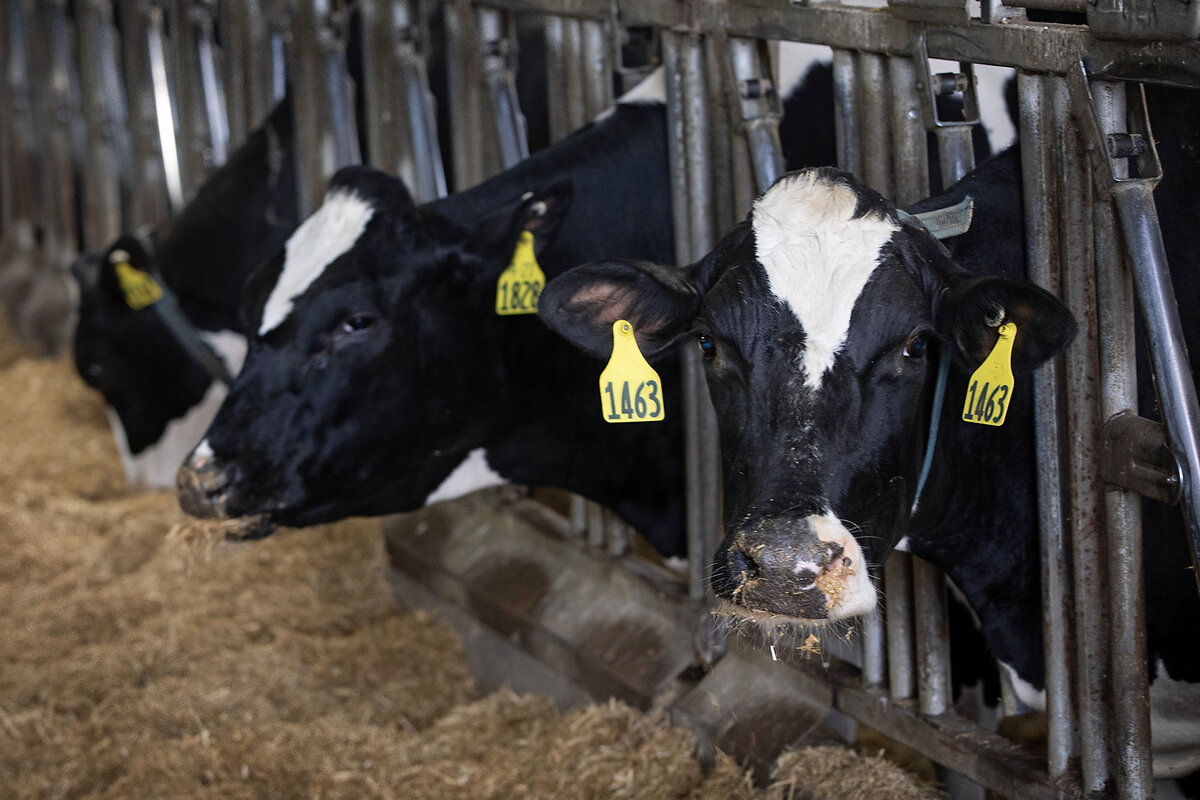
And that attention has started to focus on cows. Cows such as Number 2945, who is standing in the middle of one of Cornell’s new respiration chambers.
Although exact percentages are difficult to determine, researchers estimate that cows are responsible for around 30% of U.S. methane emissions. This is largely because cattle, like goats or sheep, are ruminants: animals with four-chambered stomachs that ferment grass and other vegetation into consumable food. And a natural by-product of rumination is methane.
Although it is a natural system, this methane production of cows has become a problem, in large part because of cattle population numbers. In short, the world has an awful lot of cattle, which translates to a lot of emissions.
According to the U.S. Department of Agriculture, there are 28.2 million beef cattle in the U.S., along with 9.36 million dairy cows and 33.6 million calves. And those numbers pale in comparison to countries such as India, which has an estimated 61 million milk cows, or Brazil, with around 234 million beef cattle.
With growing pressures from policymakers and climate advocates, then, agribusiness and scientists are trying to figure out how to make individual dairy cows more productive, which could lead to smaller herds, while at the same time trying to find ways to make cow burps — the body function that produces the most methane — less gassy.
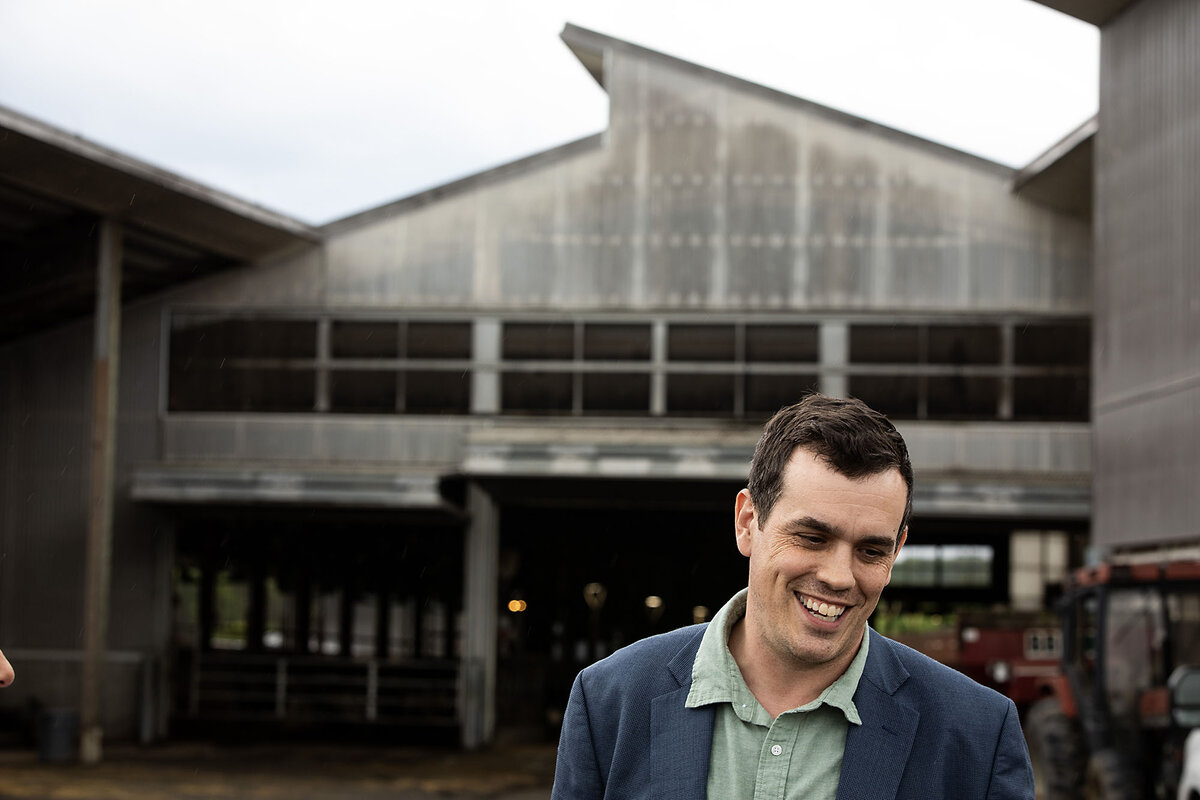
How much methane do cows produce?
The first step to doing that, says Cornell associate professor Joseph McFadden, is to get good measurements of bovine methane in the first place. Without having an accurate baseline, it’s hard to know how effective a proposed solution is – whether a feed additive, a vaccine, or even gene sequencing.
“If you’re going to pay a farmer to reduce emissions by 30%, that requires inventory data,” he says. “You have to work with farmers to figure out how much methane is produced today, how much tomorrow.”
But measuring bovine methane is easier said than done.
“This is a biological process,” says Mr. Blaustein-Rejto. “Cattle are not machines. Every animal functions a little differently, just like every person has a different microbiome and digests food differently.”
The methane production also changes based on where cows live, how old they are, and what they eat. But it would be an unusual farmer who would buy expensive machinery for each individual in a herd, or spend the time measuring the breath of every cow.
“The challenge comes in capturing the methane,” says Joe Rudek, lead senior scientist at the Environmental Defense Fund. “Cows are breathing out this methane. You’ve got them walking around in a pasture, how do you capture that methane that’s coming out of the cows’ mouth and nostrils?”
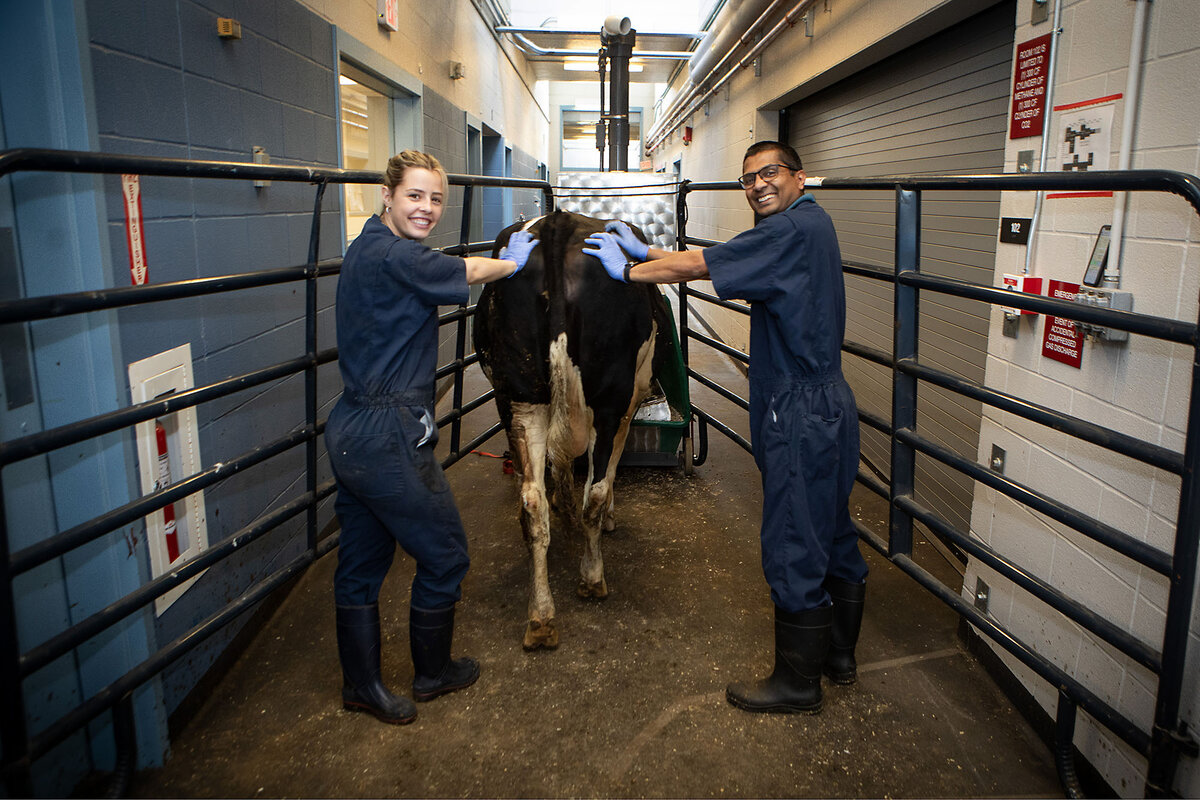
So instead of individually measuring each cow, scientists are trying to build up a robust sample size of measurements that would let them statistically predict methane emissions, both broadly and specifically. One contraption they use now is called the GreenFeed – basically a high-tech box with cow treats. When the cow puts her head into it to eat, the box measures methane and other gases. These instruments are portable, so theoretically farmers can use them in different locations.
But, Dr. McFadden says, those measurements are not always exact. That’s why his respiration chambers are important. Because the pods are highly accurate, closed systems, they can calibrate other machines.
“These are the gold standard,” he says. And it’s not just for methane, he adds. The chambers can help him monitor other inputs and outputs that can give clues about animal health and well-being, and about how the animal uses energy – as well as about other greenhouse gases, such as nitrous oxide.
Wider applications
And there is a lot of attention to what those chambers are showing.
Although only a few research centers in the U.S. focus on methane and livestock, many for-profit businesses are keenly interested in their findings. A substantial marketplace exists for methane solutions: Food companies are scrambling to meet emission pledges throughout their supply chains, while governments work to meet their own climate goals.
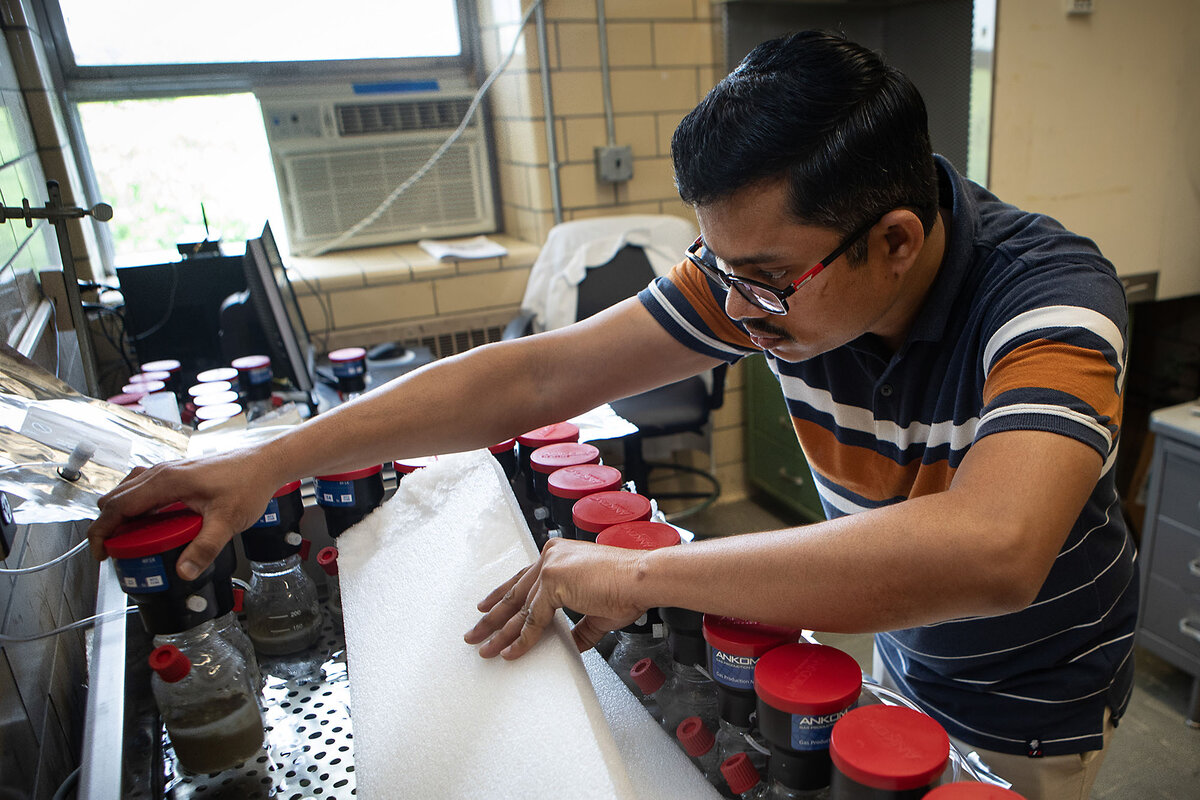
Dr. McFadden gets regular calls from startup companies asking him to test their products, but he can only do so much with the time and resources he has, he says.
It’s not straightforward to test a feed additive, for instance. Not only does the additive have to lower methane, it must not hurt the cow or pose any risk to food safety. And it should also have some benefit to cash-strapped farmers, who are loath to spend money on new products that do nothing for their bottom lines.
Across the country, at the University of California, Davis, professor Ermias Kebreab is also working with dairy cows, and has his eye on some solutions. In addition to feed additives, he is measuring what happens when cows eat local agricultural by-products, such as the grape residue from winemaking. GreenFeed measurements are finding some promising initial results, he says.
“We found a 10% to 12% reduction in emissions,” he says. “Animals were happy to eat it … and it avoids the emissions from putting it into a landfill.”
Not only that, he says, but grape pomace — the fruit’s leftover skin, seeds, or stems — seems to improve milk quality.
“It’s a win-win kind of situation,” he says.

Difference-maker
Poland has united to cut back on coal. This activist led the way.
Poland has been a historically large producer and consumer of coal for heating homes. Worried about the smog that results, one resident has united Poles to cut back on the fuel.

- Quick Read
- Deep Read ( 4 Min. )
Poland produces – and consumes – the lion’s share of the coal that the European Union uses to stay warm in winter. And when consumed, the coal results in clouds of particulate matter that contain probable carcinogens such as benzopyrene and clog the lungs.
Angry and alarmed for her children’s well-being, Anna Dworakowska rallied other young parents like her around an awareness-raising campaign about smog. “We decided that either we move out of [Kraków], or we would try and fight for our air,” she says.
Their efforts would lead to the creation of Polish Smog Alert, a national movement that has pushed through groundbreaking initiatives for cleaner air and has shifted thinking in one of Europe’s most coal-dependent, polluted countries. And it helped make Kraków the first city in Poland to ban most coal heating.
“Anna forced the public administration in Kraków to set whole new laws connected to clean air goals,” says Maciej Fijak, a local district councilor in Kraków. The Smog Alert program is “the most successful story in Polish civil society action ever.”
Poland has united to cut back on coal. This activist led the way.

Like most inhabitants of Kraków, Anna Dworakowska had never really questioned the smog.
The thick, orangey haze wraps her city, Poland’s second-largest, every winter. But she saw it as a part of the season. Nobody talked about it as anything abnormal.
But in 2012, Ms. Dworakowska’s husband, an environmental economist, showed her a scientific paper that shocked her. It said that Kraków was the European Union’s third-most-polluted city. Even more shocking, she says, was the culprit. The pollution came not from cars or industry, but from a quintessentially Polish habit: heating homes with coal.
Poland both produces and consumes the lion’s share of the coal that the EU uses to stay warm in winter – as much as 80%. And when consumed, it results in clouds of particulate matter that contain probable carcinogens such as benzopyrene and clog the lungs, making Poland into the EU country with the highest coal-related health costs. Hundreds of Cracovians have died prematurely as a result, according to several clean-air research groups, including the European Respiratory Society in Lausanne, Switzerland.
Angry and alarmed for her children’s well-being, Ms. Dworakowska rallied other young parents like her around an awareness-raising campaign about smog. “We decided that either we move out of the city, or we would try and fight for our air,” she says. Their efforts would lead to the creation of Polish Smog Alert, a national movement that has pushed through groundbreaking initiatives for cleaner air and shifted thinking in one of Europe’s most coal-dependent, polluted countries. And it helped make Kraków the first city in Poland to ban most coal heating.

“Anna forced the public administration in Kraków to set whole new laws connected to clean air goals,” says Maciej Fijak, a local district councilor in Kraków. The Smog Alert program is “the most successful story in Polish civil society action ever.”
A “smoke awakening”
Until 2012, Ms. Dworakowska had been working as an English teacher and translator specializing in environmental protection issues. But the revelation about Kraków’s self-inflicted smog problem shifted her course toward environmental activism.
“We’re breathing one of the most polluted air in the EU, and we don’t know about it,” says Ms. Dworakowska. The parents she rallied “decided that this is ridiculous.”
At the time, the Arab Spring had just shown the power of social media. Ms. Dworakowska and her allies decided to attempt a similar road, launching the Kraków Smog Alert group on Facebook. They posted daily smog emission levels and recommendations on whether it was safe to go out.
That was new for – and news to – Cracovians. “People started getting angry,” she says. “They did not know they were living in such a dirty place with such dirty air.”
And they started to add their voices to the Smog Alert cause. One Sunday in November 2012, during the peak of the smog season, thousands of residents pushed empty strollers – symbolizing that taking children out in the fresh air was potentially deadly – in a march for cleaner air in Kraków. Myriad protest actions followed, with demonstrators – from regular folks to scientists, musicians, and actors – demanding that Kraków ban coal heating, help people switch to less-polluting forms of heating, and pay the heating bills of the city’s poorest residents.
Politicians were slow to get on board. “At first, [they] would say, ‘Oh, your demands are crazy, impossible to fulfill. We cannot ban the use of coal in the city because old people will freeze to death!’” Ms. Dworakowska recalls. “They said, ‘Who is supporting you? Where do you get money from? Which side of the political divide are you on?’”
But as time went on, the political mood shifted and city hall warmed to the activists – a “smoke awakening,” Ms. Dworakowska calls it. In 2013, Kraków passed its milestone coal and wood ban, which came into force six years later. More than 20 cities across Poland have since adopted similar bans.
“A bipartisan issue”
At the same time, Ms. Dworakowska’s group was growing nationally.
In 2015, it became Polish Smog Alert, a national network with local offshoots in 50 Polish cities, which pushed for clean-air legislation at the national level. For example, Polish Smog Alert was instrumental in persuading the national government in Warsaw to ban high-polluting coal boilers, to establish national coal quality norms, and to allow cities to prohibit the entry of high-pollution cars.
And the results haven’t just been legislative. Kraków now has only 500 residents using coal for heating, compared with 30,000 in 2013. There are only 30 “smog days” a year in the city compared with 120 then. In the country as a whole, use of coal to stay warm has dropped to 50%, down from 70% in 2013.
Still, smog remains a big problem in Kraków, because heating with coal remains an entrenched habit in many of the surrounding smaller cities and villages. That’s because coal is still often seen as a symbol of Poland’s industry and independence.
“I remember being afraid of going out with my kids sometimes, as though I were stepping on the toes of a very powerful lobby group,” Ms. Dworakowska says. “People said coal is a sacred thing; we should not do anything about it. They did not understand nor did they question the impact of coal on pollution.”
Beyond legislative change, the real revolutionary power of Ms. Dworakowska’s Smog Alert program is that it has ignited a “societal mentality change,” says Zuzanna Rudzińska-Bluszcz, undersecretary of state in Poland’s department of justice and a former president of Poland’s ClientEarth Lawyers for the Earth Foundation. Coal-related smog is “one of the most important environmental issues in Poland,” she adds, and Ms. Dworakowska “is linking people from various districts of Poland together around a bipartisan issue.”
Other headline stories we’re watching
(Get live updates throughout the day.)The Monitor's View
Ukraine’s freedom, book by book
- Quick Read
- Deep Read ( 2 Min. )
-
By the Monitor's Editorial Board
The most popular book in Ukraine last year was the fictional thriller “I See You Are Interested in Darkness.” It is written by a former soldier and explores the indifference to both personal and social sins. After the Russian invasion in 2022, the book became popular because, as one reviewer put it, “indifference was no longer an option.”
Fighting a war for their survival has turned many Ukrainians into avid book readers, eager to find solace, freedom, wisdom, or, perhaps, empathy. They are aware of Russian forces trying to wipe out Ukrainian culture by, for example, destroying more than a hundred libraries.
Since the invasion, more than a hundred books have been printed for children to help them cope with the war’s trauma. The number of bookstores has expanded significantly. From May 30 to June 2, the country’s annual book festival in Kyiv drew 35,000 visitors, up from 28,000 last year. “The war has ultimately liberated Ukrainian culture from an inferiority complex” stemming from a historic preference for Russian literature, said Yulia Kozlovets, the book festival’s director.
Reading books has given Ukrainians a powerful tool for dealing with indifference to evil.
Ukraine’s freedom, book by book

The most popular book in Ukraine last year was the fictional thriller “I See You Are Interested in Darkness.” It is written by a former soldier, Illarion Pavliuk, and explores the indifference to both personal and social sins. After the Russian invasion in 2022, the book became popular because, as one reviewer put it, “indifference was no longer an option.”
Fighting a war for their survival has turned many Ukrainians into avid book readers, eager to find solace, freedom, wisdom, or, perhaps, empathy. They are aware of Russian forces trying to wipe out Ukrainian culture by, for example, destroying more than a hundred libraries.
In May, the country’s largest printing house, Factor Druk, was badly damaged by Russian missiles. Donors quickly pledged to restore the book publisher. President Volodymyr Zelenskyy likened the attack to events in Ray Bradbury’s 1953 dystopian novel “Fahrenheit 451,” the temperature at which book paper ignites. Since the invasion, more than one hundred books have been printed for children to help them cope with the war’s trauma. The number of bookstores has expanded significantly. From May 30 to June 2, the country’s annual book festival in Kyiv drew 35,000 visitors, up from 28,000 last year.
The war has provoked a period of soul-searching and steered many in Ukraine to rethink their identity, Oleksiy Erinchak, an entrepreneur who founded a bookstore in Kyiv, told Radio Free Europe/Radio Liberty. In particular, said Yulia Kozlovets, the book festival’s director, “the war has ultimately liberated Ukrainian culture from an inferiority complex” stemming from a historic preference for Russian literature.
Liberation for Ukraine is happening on more than just the military front lines. It is also a mental struggle to be free of fear and full of faith in Ukraine’s cultural independence.
Another popular book last year was “The Story of a Stubborn Man,” written by a former commander, Oleksandr Budko. He is a young war hero who lost both legs in battle. This fall, he will be on Ukraine’s version of the reality TV show “The Bachelor.” During the book festival, he was mobbed by young women who loved his book about coping with his tragedy and finding his hope in Ukraine’s victory.
Reading books has given Ukrainians a powerful tool for dealing with indifference to evil.

A Christian Science Perspective
Each weekday, the Monitor includes one clearly labeled religious article offering spiritual insight on contemporary issues, including the news. The publication – in its various forms – is produced for anyone who cares about the progress of the human endeavor around the world and seeks news reported with compassion, intelligence, and an essentially constructive lens. For many, that caring has religious roots. For many, it does not. The Monitor has always embraced both audiences. The Monitor is owned by a church – The First Church of Christ, Scientist, in Boston – whose founder was concerned with both the state of the world and the quality of available news.
What’s the assignment?
- Quick Read
- Read or Listen ( 4 Min. )
-
By Jenny Sawyer
Recognizing and building on what’s good – rather than tearing things down – is a powerful way to contribute to the world around us, and we all have the God-given ability to do this.
What’s the assignment?
In a commencement address this past spring, an American TV host and author reminded the graduating class of one of the hallmarks of their generation: recognizing and calling out the systems and institutions they feel need fixing. But, he added, the assignment isn’t to deconstruct but to reconstruct. In other words, we help our communities not by simply pointing out the problems but by participating in fixing them. By helping to heal and rebuild.
Doesn’t this apply to all of us – college students or not? We live in a time when opinions, “hot takes,” and personal commentary are a regular part of how we relate to the world and each other. But how do we shift from being mainly observers and deconstructors to being participants and reconstructors? It starts with our standpoint.
If you’re interested in discovering more about this standpoint, you might think of Jesus as the model. Jesus definitely wasn’t afraid to call out the things he saw as needing redemption – hypocrisy, ego, immorality, greed, and injustice, to name a few. But it is the intent behind his observations that’s so noteworthy. As the best representative of God’s redeeming power that the world has ever known, Christ Jesus, in his own words, did “not come to destroy, but to fulfill” (Matthew 5:17). He came to demonstrate the law of divine Love. Rather than tearing down or shaming others, Jesus awakened, redeemed, and healed them.
While many might have responded to the bad stuff with cynicism, Jesus saw that whatever appeared ugly or unredeemed about someone’s character was an incorrect perception of who they were. And instead of getting disheartened about these traits, he saw through them to who the individual truly was as God’s son or daughter.
This didn’t just change the problematic behavior; it rebuilt lives. In the case of a tax collector who’d been stealing from his community for years, Jesus’ Christly view of this man brought redemption. It ended the stealing and impelled the man to make generous restitution to everyone he’d defrauded (see Luke 19:1-10).
Jesus ushered in a new view of not just who we are but what God is. If there were any truth to the stereotypical view that God is vengeful or inclined to punish, it might make sense that the path to progress would be about punishing and tearing down. But Jesus’ fulfillment of divine law was a revelation of an actual kingdom of heaven at hand – a universe of God’s, Love’s, creating, where each of us is the image of Love.
It’s on this basis that we can move from the echo chamber of opinions and criticism to both trust in Christ and confidence that this eternal voice of Truth can show us how to see others, our systems and institutions, and even global problems in a more healing light. This is the basis for the kind of change that all of us yearn to see in the world.
This wasn’t always obvious to me. My first couple of years in college, I often spent time with a group of friends who loved to talk about what our school should be doing better. But I was jolted one day when one of those friends laughingly told me that she loved my cynicism.
I didn’t want to be a cynic, so I began asking myself, “If cynicism isn’t the answer, what is?” I knew from attending a Christian Science Sunday School that the answer was love. But could love accomplish what “smarts” couldn’t?
It’s surprising how easy it is to be blinded by the belief that tearing down is more effective than recognizing and building on what’s good. But over and over during those same college years, I’d experienced healings with my friends and professors – always when I let divine Love imbue my thoughts. Love is the power that quiets our fears so we can love others enough to heal a misunderstanding. Love is the presence that comforts our broken hearts so we can begin seeing the goodness in ourselves and others that may not always be apparent.
That recognition was a turning point in my prayers, and though it’s not as if I’ve never dealt with cynicism again, knowing what Love is and does has been a solid foundation to build on.
“Love is reflected in love,” wrote Mary Baker Eddy, the founder of The Christian Science Monitor (“Science and Health with Key to the Scriptures,” p. 17). When it feels difficult to see past what needs fixing, it’s comforting to recognize that love is innate to each of us – part of our true, spiritual nature. And it’s because we are sourced in Love that we are inevitably impelled beyond opinions to loving thoughts and constructive actions. Love compels us to heal. This, you could say, is our ultimate “assignment.” And we were each created entirely capable of fulfilling it.
Adapted from an editorial published in the July 29, 2024, issue of the Christian Science Sentinel.

Viewfinder
Putting a spin on things

A look ahead
Thank you for joining us today. Please come back tomorrow when Henry Gass looks at President Joe Biden’s proposal to reform the Supreme Court. What would those changes look like in practice, and what could they mean for the court?


